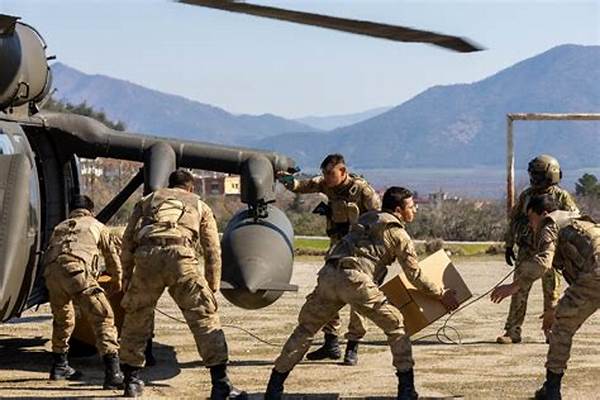In contemporary global affairs, the interplay between military operations and humanitarian efforts has garnered considerable attention. The dynamic synergy often demonstrated through humanitarian assistance and military collaboration is pivotal for the effective delivery of aid and relief in crisis-stricken regions. This collaboration entails coordinated efforts aimed at swiftly addressing the needs of affected populations, mitigating further human suffering, and fostering stability in volatile environments. Recognizing the significance of these joint endeavors, it becomes essential to delve into the complexities and impacts of military involvement in humanitarian missions.
The Necessity of Military Collaboration in Humanitarian Missions
Humanitarian assistance often requires rapid response capabilities that can be effectively bolstered by military collaboration. The logistical prowess of military units, characterized by their ability to mobilize quickly and operate under adverse conditions, is crucial to delivering aid in a timely manner. Furthermore, military forces possess specialized equipment and expertise that can facilitate the establishment of essential infrastructure, such as temporary shelters and transportation networks, which are critical in the immediate aftermath of natural disasters or conflicts.
Moreover, humanitarian assistance efforts conducted in partnership with military entities benefit from enhanced security measures. In regions plagued by conflict or instability, the presence of military personnel can provide the necessary protection for aid workers and beneficiaries, ensuring that assistance reaches those in need without compromising safety. Consequently, the integration of military collaboration into humanitarian missions not only expedites the delivery of aid but also ensures that it reaches its intended recipients efficiently and securely.
Key Elements of Humanitarian Assistance and Military Collaboration
1. Logistical Support: Humanitarian assistance missions significantly benefit from military collaboration, as the military provides advanced logistical support, enabling faster deployment of resources to crisis areas.
2. Security and Protection: Military collaboration ensures a secure environment for humanitarian workers, thereby allowing aid to be delivered safely in volatile or hostile regions.
3. Infrastructure Development: In many instances, military collaboration aids in the rapid construction of necessary infrastructure, boosting the efficiency of humanitarian assistance operations.
4. Resource Mobilization: The military’s vast resources, such as transportation and communication systems, are instrumental in enhancing the outreach of humanitarian assistance.
5. Coordination and Planning: Effective humanitarian assistance requires meticulous planning and coordination, which is significantly streamlined through military collaboration, given their structured and disciplined approaches.
Challenges in Humanitarian Assistance and Military Collaboration
Despite their effectiveness, humanitarian assistance and military collaboration face various challenges. One of the primary concerns is the risk of blurring the lines between humanitarian efforts and military objectives, which may lead to perceptions of partiality or compromise neutrality. This can potentially jeopardize the impartial nature of humanitarian work and affect the trust of local communities or beneficiaries.
Additionally, there are logistical and communication challenges inherent in integrating civilian humanitarian actors and military organizations. Differing operational cultures and priorities can hinder seamless collaboration. To mitigate these issues, comprehensive training and joint exercises between civilian and military entities are essential. These initiatives foster mutual understanding and create a cohesive operational framework that ensures humanitarian assistance is delivered efficiently and ethically.
Governance and Frameworks in Humanitarian Assistance and Military Collaboration
The governance of humanitarian assistance and military collaboration is guided by international frameworks that ensure compliance with humanitarian principles. Protocols established by global bodies such as the United Nations delineate roles and responsibilities to prevent the exploitation of humanitarian missions for military purposes. Maintaining transparency and accountability is paramount to sustaining the credibility and effectiveness of such collaborations.
Moreover, integrating local stakeholders in the decision-making process is crucial to tailoring humanitarian assistance to the specific needs of affected communities. This ensures that military support is utilized appropriately and does not overshadow local capacities. A collaborative approach founded on mutual respect and partnership is essential for aligning humanitarian assistance endeavors with the overarching objectives of long-term stability and development in crisis-affected regions.
Future Prospects for Humanitarian Assistance and Military Collaboration
As global humanitarian challenges continue to evolve, the role of military collaboration in delivering assistance will likely expand. Climate change, armed conflicts, and pandemics underscore the need for robust and flexible response mechanisms. Humanitarian assistance will thus increasingly rely on military collaboration to navigate complex emergencies and deliver timely aid.
Advancements in technology offer promising enhancements to these collaborative efforts. The integration of innovative tools such as drones for aerial reconnaissance and digital platforms for real-time data sharing can enhance the precision and efficacy of humanitarian missions. Embracing these advancements while upholding the core principles of humanitarianism will be key to optimizing the impact of military collaboration in future humanitarian endeavors.
Summary
In sum, the synergistic relationship between humanitarian assistance and military collaboration plays a pivotal role in addressing crises efficiently and effectively. By leveraging the unique strengths of the military, humanitarian actors can overcome logistical and security challenges, enabling prompt and secure delivery of aid. Nevertheless, it is crucial to navigate the potential pitfalls associated with this collaboration, particularly concerning neutrality and cultural differences.
Strategically governed by international frameworks and informed by technological advancements, the future of humanitarian assistance and military collaboration holds great promise. Continued dialogue, training, and partnership-building will be critical in optimizing the efficacy of these collaborations, ultimately enhancing the humanitarian sector’s capacity to alleviate suffering and foster resilience in the face of global challenges. The commitment to maintaining the core humanitarian principles while expanding collaborative efforts remains integral to the success of these vital missions.





